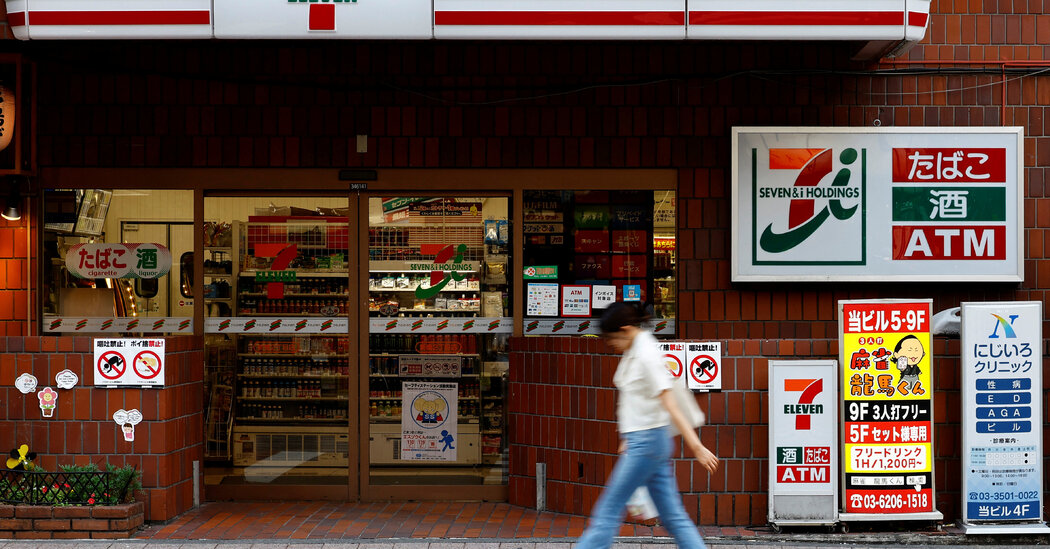in Japan, convenience stores are celebrated. Clear and shiny, they’re stocked with recent and reasonably priced lunch packing containers, steamed buns and winter stews. Celeb chef Anthony Bourdain as soon as known as them “the one vice” he could not quit.
For a lot of residents, the greater than 55,000 cheerful, jingle-filled outlets often known as konbini are an indispensable a part of on a regular basis life. Hundreds of thousands flock to shops every day to select up meals, ship packages and pay payments.
Japan’s largest konbini chain, 7-Eleven, can also be probably the most well-known. It is comprehensible {that a} rival firm needs in on the motion.
this week Seven & i Holdingsthe Japanese firm that operates 7-Eleven stated it had obtained an unsolicited takeover supply from Alimentation Couche-Tard, the Canadian comfort retailer large.
The state of 7-Eleven stores as a cornerstone of Japanese society additionally implies that Japan most likely will not need to half with them, although increasing pressure on nationwide companies to exhibit openness to overseas acquisitions.
7-Eleven is “top-of-the-line brick-and-mortar retail companies on the earth,” stated Hiroaki Watanabe, an unbiased retail analyst. Promoting 7-Eleven to Couche-Tard can be, for Japan, “equal to turning Toyota right into a overseas firm,” he stated.
The truth is, 7-Eleven began an American chain of shops operated by Southland Company in Dallas in 1927. It opened its first retailer in Japan in 1974, that includes standard American merchandise equivalent to hamburgers. It was an prompt success in Japan and inside two years expanded to 100 shops.
In 1991, Japanese grocery store operator Ito-Yokado and 7-Eleven Japan acquired a 70 p.c stake in Southland. In 2005, 7-Eleven grew to become wholly Japanese owned by way of a holding firm, Seven and me.
At the moment, Seven & i has greater than 21,000 7-Eleven shops in Japan and operates in 20 international locations and territories. In the USA, Seven & i is exploring methods to copy the much-coveted Japanese retailer expertise. One risk: Enter ramen noodles.
Not like Japanese konbini outlets, North American ones convenience stores they’re typically seen as locations for packaged snacks, drinks and in lots of instances petrol. Comfort retailer sizzling meals normally conjure up photographs of a lone sizzling canine spinning for hours in an induction oven.
Quebec-based Couche-Tard operates many of those shops in the USA below its Circle Okay model.
The corporate operates greater than 16,000 shops and fuel stations in North America and Europe. Like Seven & i, the Canadian retailer is searching for additional progress abroad. In 2021, it tried to accumulate French grocery retailer operator Carrefour, an try that regulators in the end scuttled.
Japan has lengthy been a part of Couche-Tard’s world ambitions. If the acquisition of Couche-Tard succeeds, it won’t solely signify the biggest overseas acquisition of a Japanese firm, but in addition create one of many largest retail teams on the earth.
Following the information of Couche-Tard’s preliminary takeover bid, Seven & i introduced that it had established an unbiased particular committee to overview the bid.
Analysts level to important hurdles that will seemingly make a buyout of Seven & ia a long-term shot.
On the one hand, Seven & i is a conglomerate with non-store companies, together with banking and transport providers. The scope of the holding firm opens the acquisition to extra intense scrutiny from the Japanese authorities.
There are additionally large variations in how Couche-Tard and Seven & i work convenience stores.
Japanese konbini operators are identified for his or her fast growth of recent merchandise – equivalent to themed items accessible solely through the fleeting cherry blossom season. A typical comfort retailer in Japan carries about 3,000 merchandise, 70 p.c of that are changed yearly, in accordance with analyst Mr. Watanabe.
A lot of Seven & i’s working revenue comes from its Japanese shops, and Couche-Tard might want to current a compelling proposal displaying the way it can enhance that core enterprise, he stated.
Mr. Watanabe as soon as took a two-week drive throughout the USA, learning comfort shops alongside the best way — and was not impressed. Any takeover bid for 7-Eleven can be difficult as a result of Japanese shops are “utterly totally different and distinctive,” he stated.
Japan’s first 7-Eleven retailer opened in 1974 in a quiet waterfront neighborhood in jap Tokyo. Friday morning was bustling with workplace staff, college students and fogeys with younger youngsters.
Sakura Kobayashi, 23, who works within the neighborhood, stopped by to purchase a salad and onigiri rice ball — a specialty in Japanese shops. The meals at 7-Eleven has a style that feels “acquainted” to her and her co-workers, she stated.
Exterior the 7-Eleven downtown Tokyo, Yuta Matsumura, a 26-year-old workplace employee, eats a freshly purchased pancake dessert with cream. He stated he normally stops at 7-Eleven at the least 3 times every week, generally to purchase lunch objects like beef rice bowls.
Nevertheless it’s really the sweets that attraction to Mr. Matsumura. “They don’t seem to be too candy like we Japanese like,” he stated. “7-Eleven desserts are one of the best.”

